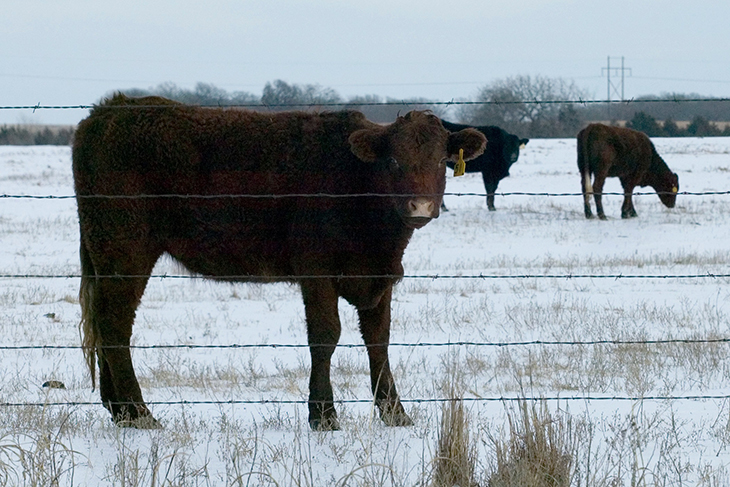How Much Hay Does 1 Beef Cow Eat in a Year

Calculation of livestock's winter feed needs a must for cow-calf producers
Monday, November 12, 2018
Snowy weather has swept southward through the Great Plains, reminding cow-calf producers that winter hay feeding has come to Oklahoma, or soon will be.
Hay or standing forage intake must be estimated in order to calculate winter feed needs of cattle, reminds Glenn Selk, Oklahoma State University Cooperative Extension emeritus animal scientist and managing editor of the university's popular Cow-Calf Corner newsletter.
"Forage quality will be a determining factor in the amount of forage consumed," he said. "Higher-quality forages contain larger concentrations of important nutrients, so animals consuming these forages should be more likely to meet their nutrient needs from the forages, plus cows can consume a larger quantity of higher-quality forages."
Higher-quality forages are fermented more rapidly in the rumen, leaving a void cattle can refill with additional forage. Consequently, forage intake increases. For example, low-quality forages – below about 6 percent crude protein – will be consumed at a rate about 1.5 percent of body weight on a dry matter basis per day. Higher-quality grass hays – 8 percent or more crude protein – may be consumed at about 2 percent of body weight.
"Excellent forages such as good alfalfa, silages or green pasture may be consumed at the rate of 2.5 percent dry matter of body weight per day," Selk said. "The combination of increased nutrient content and increased forage intake makes high-quality forage very valuable to the animal, not to mention the producer's wallet and management options. With these intake estimates, producers can calculate the estimated amounts of hay that need to be available."
Take the following example of 1,200-pound pregnant spring-calving cows with access to good-quality grass hay that tested out at 8 percent crude protein. Cows will voluntarily consume about 2 percent of their body weight or 24 pounds per day. The 24 pounds is based on 100 percent dry matter. Grass hays often will be 7 percent to 10 percent moisture.
"If we assume the hay is 92 percent dry matter or 8 percent moisture, then the cows will consume about 26 pounds per day on an as-fed basis," Selk said. "Unfortunately, it is also necessary to consider hay wastage when feeding big round bales. Hay wastage is difficult to estimate, but generally has been found to range from 6 percent to 20 percent or more."
For the above example, assume 15 percent hay wastage. This calculates out to approximately 30 pounds of grass hay that must be hauled to the pasture for each cow, each day, that hay is expected to be the primary ingredient in the herd's diet.
"After calving and during early lactation, the cow may weigh 100 pounds less, but will be able to consume about 2.6 percent of her body weight in hay, based on 100 percent dry matter," Selk said. "This would translate into 36 pounds of as-fed hay per cow, per day, necessary to be hauled to the pasture. This again assumes 15 percent hay wastage."
Accurate knowledge of average cow size in a producer's specific herd, as well as the average weight of the operation's big round bales, becomes necessary to predict hay needs and hay feeding strategies.
"Big round hay bales will vary in weight," Selk said. "Diameter and length of the bale, density of the bale, the type of hay and moisture content will greatly influence a bale's weight. Weighing a pickup or trailer with and without a bale may be the best method to estimate bale weights."
Oklahoma ranks as the nation's second-leading producer of beef cows, according to USDA National Agricultural Statistics Service data.
The Oklahoma Cooperative Extension Service is one of two state agencies administered by OSU's Division of Agricultural Sciences and Natural Resources, and is a key part of the university's state and federally mandated teaching, research and Extension land-grant mission.
By Donald Stotts
SVG directory not found.
Source: https://news.okstate.edu/articles/agriculture/2018/stotts_selk-cows-consuming-forage.html
0 Response to "How Much Hay Does 1 Beef Cow Eat in a Year"
Post a Comment